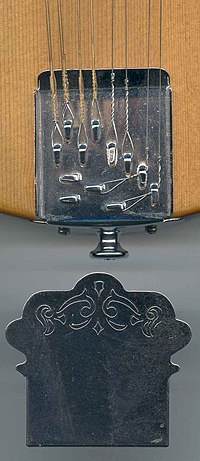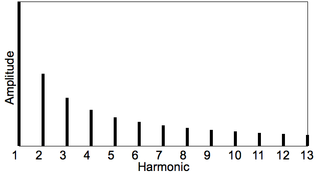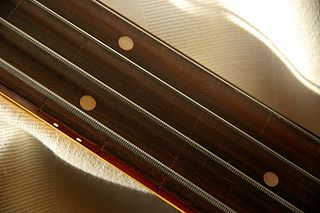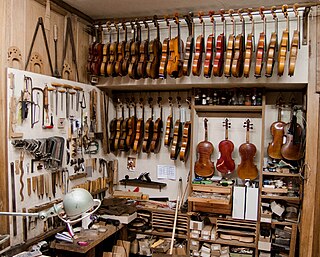| Look up tailpiece in Wiktionary, the free dictionary. |


A tailpiece is a component on many stringed musical instruments that anchors one end of the strings, usually opposite the end with the tuning mechanism (the scroll, headstock, peghead, etc.).
| Look up tailpiece in Wiktionary, the free dictionary. |


A tailpiece is a component on many stringed musical instruments that anchors one end of the strings, usually opposite the end with the tuning mechanism (the scroll, headstock, peghead, etc.).

The tailpiece anchors the strings, so it must be strong enough to withstand their combined tension. Tailpieces of the violin family or viol families of instruments, including double basses, are attached by a "tailgut" looped around the tailpin or end button, which is let into the bottom bock of the instrument. [1] Originally made of animal gut and adjusted with difficulty by means of a knot, tailguts are now usually made of wire or nylon monofilament, and easily adjusted with threaded collars, usually made of brass, on the ends.
Tailpieces are made of many materials. Violin tailpieces are typically made of wood: ebony, rosewood, boxwood, or rarely pernambuco. Other materials include cast light metal, and composites including plastic. Choice of material may have more than just cosmetic effect; a well-made instrument is sensitive to tailpiece weight, mass distribution, and tailgut placement on the saddle. Fretted string instrument tailpieces are typically made of metal.
Violin tailpieces come in various shapes. Some resemble a tulip or a goblet. The common Hill style has a central longitudinal ridge that gives it a faceted appearance. Some violin tailpieces feature decorative elements, as shell inlays or ornate stylized or figurative carvings.
Devices called "fine-tuners" are sometimes used to assist in the tuning of the instrument; they may either be affixed to the tailpiece or built into its design. Most modern violinists, regardless of what other strings they use, play an E with a solid steel core, which may be overly touchy to tune with the traditional tuning pegs. For convenience in tuning, the added mass of a single fine tuner is a tolerable trade-off. Four fine tuners are advantageous when tuning a set of metal-core strings.
Some electric guitar tailpieces feature a vibrato bar , which a player uses to alter the pitch of all strings at once for various musical effects.
A well-set-up instrument from the violin family will have attention paid to the tuning of the afterlength, or string length on the tailpiece side of the bridge. On many instruments it is set to 1/6 the playing length, or length between nut and bridge, sounding two octaves and a fifth above the open note of the playing length. [2] This tuning may be varied to give certain desired effects. [3]

The cello ( CHEL-oh; plural celli or cellos) or violoncello ( VY-ə-lən-CHEL-oh; Italian pronunciation: [vjolonˈtʃɛllo]) is a bowed (and occasionally plucked) string instrument of the violin family. Its four strings are usually tuned in perfect fifths: from low to high, C2, G2, D3 and A3, an octave lower than the viola. Music for the cello is generally written in the bass clef, with tenor clef and treble clef used for higher-range passages.

An electric guitar is a guitar that requires external amplification in order to be heard at typical performance volumes. It uses one or more pickups to convert the vibration of its strings into electrical signals, which ultimately are reproduced as sound by loudspeakers. The sound can be shaped or electronically altered to achieve different timbres or tonal qualities, often making it quite different than an acoustic guitar. Often, this is done through the use of effects such as reverb, distortion and "overdrive"; the latter is considered to be a key element of electric blues guitar music and rock guitar playing.

The guitar is a fretted musical instrument that usually has six strings. It is typically played with both hands by strumming or plucking the strings with either a guitar pick or the fingers/fingernails of one hand, while simultaneously fretting with the fingers of the other hand. The sound of the vibrating strings is projected either acoustically, by means of the hollow chamber of the guitar, or through an electrical amplifier and a speaker.
A mandolin is a stringed musical instrument in the lute family and is usually plucked with a plectrum. It commonly has four courses of doubled metal strings tuned in unison, although five and six course versions also exist. The courses are typically tuned in a succession of perfect fifths, with the same tuning as a violin. It is the soprano member of a family that includes the mandola, octave mandolin, mandocello and mandobass.

The violin, sometimes known as a fiddle, is a wooden string instrument in the violin family. Most violins have a hollow wooden body. It is the smallest and highest-pitched instrument (soprano) in the family in regular use. The violin typically has four strings, usually tuned in perfect fifths with notes G3, D4, A4, E5, and is most commonly played by drawing a bow across its strings. It can also be played by plucking the strings with the fingers (pizzicato) and, in specialized cases, by striking the strings with the wooden side of the bow.

String instruments, stringed instruments, or chordophones are musical instruments that produce sound from vibrating strings when the performer plays or sounds the strings in some manner.

A mute is a device fitted to a musical instrument to alter the sound produced: by affecting the timbre, reducing the volume, or most commonly both. The use of a mute is usually indicated in musical notation by the Italian direction con sordino and removed with the direction senza sordino or via sordino. The spelling sordino is standard in musical notation, but in Italian, the proper spelling is sordina.

In music, inharmonicity is the degree to which the frequencies of overtones depart from whole multiples of the fundamental frequency.

An archtop guitar is a hollow steel-stringed acoustic or semiacoustic guitar with a full body and a distinctive arched top, whose sound is particularly popular with jazz, blues, and rockabilly players.
A vibrato system on a guitar is a mechanical device used to temporarily change the pitch of the strings. Instruments without a vibrato have other bridge and tailpiece systems. They add vibrato to the sound by changing the tension of the strings, typically at the bridge or tailpiece of an electric guitar using a controlling lever, which is alternately referred to as a whammy bar, vibrato bar, or incorrectly as a tremolo arm. The lever enables the player to quickly and temporarily vary the tension and sometimes length of the strings, changing the pitch to create a vibrato, portamento, or pitch bend effect.

A Baroque violin is a violin set up in the manner of the baroque period of music. The term includes original instruments which have survived unmodified since the Baroque period, as well as later instruments adjusted to the baroque setup, and modern replicas. Baroque violins have become relatively common in recent decades thanks to historically informed performance, with violinists returning to older models of instrument to achieve an authentic sound.

A string is the vibrating element that produces sound in string instruments such as the guitar, harp, piano, and members of the violin family. Strings are lengths of a flexible material that a musical instrument holds under tension so that they can vibrate freely, but controllably. Strings may be "plain", consisting only of a single material, like steel, nylon, or gut, or wound, having a "core" of one material and an overwinding of another. This is to make the string vibrate at the desired pitch, while maintaining a low profile and sufficient flexibility for playability.

The zhongruan, is a Chinese plucked string instrument. The zhongruan has a straight neck with 24 frets on the fingerboard and 4 strings. It is usually played with a plectrum. It can also be played with fingers, which is similar to the way of playing the pipa (琵琶). The zhongruan is a tenor-ranged instrument in the family of ruan (阮). In ancient China, the ruan was called Qin pipa or Ruan xian (阮咸). Now the ruan has expanded to different sizes and the zhongruan is the "medium" one.

A variety of methods are used to tune different stringed instruments. Most change the pitch produced when the string is played by adjusting the tension of the strings.

Making an instrument of the violin family, also called lutherie, may be done in different ways, many of which have changed very little in nearly 500 years since the first violins were made. Some violins, called "bench-made" instruments, are made by a single individual, either a master maker, or an advanced amateur working alone. Several people may participate in the making of a "shop-made" instrument, working under the supervision of a master. Various levels of "trade violin" exist, often mass-produced by workers who each focus on a small part of the overall job, with or without the aid of machinery.

A violin consists of a body or corpus, a neck, a finger board, a bridge, a soundpost, four strings, and various fittings. The fittings are the tuning pegs, tailpiece and tailgut, endpin, possibly one or more fine tuners on the tailpiece, and in the modern style of playing, usually a chinrest, either attached with the cup directly over the tailpiece or to the left of it. There are many variations of chinrests such as clamped to the body in the center, on either side of the tailpiece as with a Guaneri style chinrest or to the left of the tailpiece.

Playing the violin entails holding the instrument between the jaw and the collar bone.. The strings are sounded either by drawing the bow across them (arco), or by plucking them (pizzicato). The left hand regulates the sounding length of the strings by stopping them against the fingerboard with the fingers, producing different pitches.

In music, an electronic tuner is a device that detects and displays the pitch of musical notes played on a musical instrument. "Pitch" is the highness or lowness of a musical note, which is typically measured in Hertz. Simple tuners indicate—typically with an analog needle-dial, LEDs, or an LCD screen—whether a pitch is lower, higher, or equal to the desired pitch. In the 2010s, software applications can turn a smartphone, tablet, or personal computer into a tuner. More complex and expensive tuners indicate pitch more precisely. Tuners vary in size from units that fit in a pocket to 19" rack-mount units. Instrument technicians and piano tuners typically use more expensive, accurate tuners.

A stoptail bridge used on a solid body electric guitar or archtop guitar is a specialized kind of fixed hard-tail bridge. Hard-tail bridged guitars use different bridges from those guitars fitted with vibrato systems.

A bridge is a device that supports the strings on a stringed musical instrument and transmits the vibration of those strings to another structural component of the instrument—typically a soundboard, such as the top of a guitar or violin—which transfers the sound to the surrounding air. Depending on the instrument, the bridge may be made of carved wood, metal or other materials. The bridge supports the strings and holds them over the body of the instrument under tension.
The shorter the afterlength, the tamer, more refined, more mellow and round the sound will be, but power and freedom of the instrument can suffer.